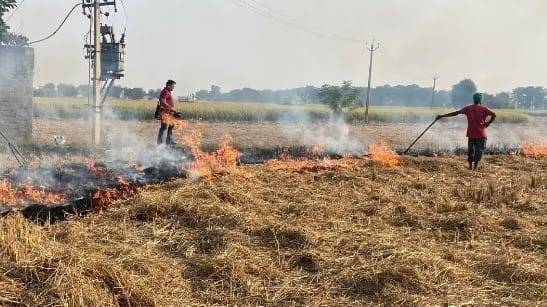Main Points In Hindi (मुख्य बातें – हिंदी में)
यहाँ दिल्ली में प्रदूषण के बारे में सीएसई मीडिया रिसोर्स सेंटर की रिपोर्ट के 3 से 5 मुख्य बिंदु दिए गए हैं:
-
प्रदूषण के स्रोत: रिपोर्ट के अनुसार, दिल्ली के वायु प्रदूषण में स्थानीय स्रोतों का योगदान 30.34%, एनसीआर जिलों का 34.97% और अन्य जिलों का 27.94% है। जबकि पराली जलाने की घटनाओं का योगदान मात्र 8.19% है।
-
पराली जलाने में कमी: 2018 में प्रभावित कृषि अपशिष्ट प्रबंधन योजना की शुरुआत के बाद, पिछले वर्ष की तुलना में 2023 में पराली जलाने की घटनाओं में 51.5% की कमी आई है। पंजाब में 6611 और हरियाणा में 981 घटनाएं दर्ज की गई हैं, जो क्रमशः 72% और 41% कम हैं।
-
कृषि के लिए प्रोत्साहन: केंद्र सरकार ने पराली प्रबंधन के लिए विभिन्न योजनाएँ शुरू की हैं, जिसमें किसानों को मशीनरी खरीदने पर 50% आर्थिक सहायता और सहकारी समितियों को 80% सहायता दी जा रही है।
-
विस्तृत जागरूकता और मशीनरी का प्रयोग: सरकार द्वारा किसानो को मशीनरी के प्रभावी उपयोग के लिए जानकारी और शिक्षा प्रदान करने के लिए भी वित्तीय सहायता दी जा रही है। इसमें ICAR द्वारा अनुशंसित उपकरणों की उपयोगिता पर जोर दिया गया है।
- राज्य सरकारों को सहायता: केंद्र सरकार ने 2018-19 से राज्य सरकारों को पराली जलाने को रोकने के लिए महत्वपूर्ण वित्तीय सहायता प्रदान की है, जिसमें पंजाब को 1681.45 करोड़, हरियाणा को 1081.71 करोड़, और यूपी को 763.67 करोड़ रुपये शामिल हैं।
Main Points In English(मुख्य बातें – अंग्रेज़ी में)
Here are the main points regarding the recent report from the CSE Media Resource Center on pollution in Delhi and the efforts to manage stubble burning:


-
Sources of Air Pollution: The report identifies that local sources contribute 30.34%, NCR districts contribute 34.97%, and other districts contribute 27.94% to air pollution in Delhi, while stubble burning accounts for only 8.19%. There has been a noted decline in stubble-burning incidents due to government efforts.
-
Reduction in Stubble Burning: The implementation of the Crop Residue Management Scheme in 2018 has led to a 51.5% decrease in stubble burning in the 2023 season. Significant reductions were also noted in Punjab (72%) and Haryana (41%) compared to last year.
-
Government Initiatives: The Ministry of Agriculture and Farmers Welfare is actively promoting paddy straw management through financial assistance for purchasing machinery and setting up Custom Hiring Centers, supporting rural entrepreneurs and cooperative societies.
-
Financial Support and Guidelines Improvement: The government has revised the scheme’s guidelines and increased financial assistance, including 50% subsidies for farmers and up to 80% for cooperatives. Significant funding has been provided to various states to support stubble management efforts.
- Machinery and Equipment Promotion: The scheme encourages the use of recommended agricultural machinery for crop residue management, helping farmers efficiently manage stubble without resorting to burning, thereby further alleviating pollution in the region.
Complete News In Hindi(पूरी खबर – हिंदी में)
हाल ही में, CSE मीडिया रिसोर्स सेंटर ने दिल्ली में प्रदूषण के बारे में एक रिपोर्ट जारी की है। इस रिपोर्ट में दिल्ली में एयर प्यूलution के मुख्य स्रोतों का आंकलन किया गया है। यह आंकलन 12 अक्टूबर 2024 से 3 नवंबर 2024 के बीच किया गया है। इसमें पाया गया कि दिल्ली के स्थानीय स्रोत 30.34 प्रतिशत प्रदूषण के लिए जिम्मेदार हैं, जबकि NCR के जिले 34.97 प्रतिशत में योगदान देते हैं। अन्य जिलों का योगदान 27.94 प्रतिशत है। इस बीच, फसल अवशेष-जलाने की घटनाओं का योगदान केवल 8.19 प्रतिशत है। पिछले कुछ वर्षों में फसल अवशेष जलाने की घटनाओं में बड़ी कमी आई है, जिसमें केंद्रीय सरकार की भी महत्वपूर्ण भूमिका है।
फसल आग लगने की घटनाओं में बड़ी कमी
2018 में भारतीय सरकार द्वारा शुरू की गई फसल अवशेष प्रबंधन योजना के तहत सभी पक्षों के प्रयासों से, 2023 सीजन में धान के फसल अवशेष जलाने में 51.5% की कमी आई है। उत्तर प्रदेश के NCR क्षेत्र में कुछ अधिक घटनाएं दर्ज की गई हैं क्योंकि अन्य कृषि अपशिष्ट जैसे गन्ना, कचरा आदि जलाने के कारण वहां और भी मामले सामने आए। वर्तमान वर्ष में यानी 10 नवंबर तक, पंजाब में 6611 और हरियाणा में 981 फसल आग लगने की घटनाएं रिकॉर्ड की गई हैं, जो कि पिछले वर्ष की इसी तारीख की तुलना में क्रमशः 72% और 41% कम हैं।
किसान बासमती धान की भूसी नहीं जलाते
कृषि और किसान कल्याण मंत्रालय ने धान के भूसे के प्रभावी प्रबंधन और प्रदूषण नियंत्रण के लिए कई पहल की हैं। बता दें कि पंजाब और हरियाणा में लगभग 45 लाख हेक्टेयर में धान की खेती हो रही है, जिनमें से लगभग 15 लाख हेक्टेयर बासमती और 30 लाख हेक्टेयर गैर-बासमती है। आमतौर पर किसान बासमती धान का भूसा नहीं जलाते।
अधिक जानकारी के लिए पढ़ें – दिल्ली: कभी अधिक भूसे जलाने से कम प्रदूषण, कभी कम जलाने से अधिक प्रदूषण, जानिए इसका कारण
केंद्र ने 6 साल पहले शुरू की योजना
धान की फ़सल की कटाई और अगली रबी की फ़सल की बुवाई के बीच के कम समय के कारण, किसान पंजाब, हरियाणा और उत्तर प्रदेश के गंगा मैदानों में भूसे को जलाते हैं। 2018-19 से, पंजाब, हरियाणा, उत्तर प्रदेश और दिल्ली की सरकारों के प्रयासों का समर्थन करने के लिए, फसल अवशेष जलाने के कारण होने वाले वायु प्रदूषण को कम करने के लिए और फसल अवशेष प्रबंधन के लिए आवश्यक मशीनरी की सब्सिडी देने के लिए एक केंद्रीय क्षेत्रीय योजना को लागू किया गया है।
इस वर्ष योजना में सुधार
इस योजना को अधिक प्रभावी बनाने के लिए कि अधिकतम किसान इसका लाभ उठा सकें, इस वर्ष मार्च 2024 में दिशा-निदेशों में सुधार किए गए हैं। इस योजना के तहत, किसानों को फसल अवशेष प्रबंधन मशीनरी खरीदने के लिए 50 प्रतिशत की वित्तीय सहायता दी जाती है। इसके अलावा, ग्रामीण उद्यमियों को, जो ग्रामीण युवा और किसान के रूप में उद्यमी हैं, कस्टम हायरिंग सेंटर स्थापित करने के लिए सहायता भी मिलती है। सहकारी समितियों, पंजीकृत किसान समितियों, FPOs और पंचायतों के लिए 80 प्रतिशत की वित्तीय सहायता दी जाती है।
मशीनरी का उपयोग बढ़ाने की दिशा में प्रयास
धान के सप्लाई चेन परियोजनाओं पर मशीनरी और उपकरणों की पूंजी लागत पर 1.50 करोड़ रुपये भी दिए जाते हैं, जैसे उच्च एचपी ट्रैक्टर, कटर, टेडर, मध्य से बड़े बैलर्स, रेकर्स, लोडर, ग्रैबर और टेलीहैंडलर। राज्यों और ICAR को फसल अवशेष प्रबंधन पर किसानों को जागरूक करने के लिए जानकारी, शिक्षा और संचार गतिविधियों के लिए भी वित्तीय सहायता दी जाती है।
यह योजना फसल अवशेष प्रबंधन के लिए भारतीय कृषि अनुसंधान परिषद (ICAR) द्वारा अनुशंसित मशीनों और उपकरणों के उपयोग को बढ़ावा देती है, जैसे सुपर स्ट्रॉ प्रबंधन सिस्टम, हैप्पी सीडर, सुपर सीडर, स्मार्ट सीडर, जीरो टिल सीड-कम-फर्टिलाइजर ड्रिल, मलचर, श्रब मास्टर/रोटरी स्लेशर, धान का भूसा चॉपर, हाइड्रोलिक रिवर्सिबल मोल्ड बोर्ड प्लाउ।
राज्यों को दी गई इतनी सहायता
केंद्रीय सरकार फसल अवशेष जलाने को रोकने और प्रबंधित करने के प्रयासों में राज्य सरकारों को 2018-19 से समर्थन दे रही है। इस अवधि के दौरान, केंद्र ने पंजाब को 1681.45 करोड़ रुपये, हरियाणा को 1081.71 करोड़ रुपये, उत्तर प्रदेश को 763.67 करोड़ रुपये, दिल्ली राष्ट्रीय राजधानी क्षेत्र को 6.05 करोड़ रुपये और भारतीय कृषि अनुसंधान परिषद को 83.68 करोड़ रुपये दिए हैं। केंद्र ने तीन लाख से अधिक मशीनें वितरित की हैं और फसल अवशेष प्रबंधन मशीनों के 41,000 से अधिक कस्टम हायरिंग सेंटर्स (CHCs) बनाए हैं।
Complete News In English(पूरी खबर – अंग्रेज़ी में)
Recently, CSE Media Resource Center has released a report regarding pollution in Delhi. In this, the main sources of air pollution in Delhi have been quantitatively evaluated. The evaluation has been done from October 12, 2024 to November 3, 2024. In this, local sources of Delhi contribute 30.34 percent to air pollution in Delhi, while NCR districts contribute 34.97 percent. Whereas, other districts are contributing 27.94 percent. Apart from all this, the contribution of the most discussed incidents of stubble burning is only 8.19 percent. There has been a huge decline in the incidents of stubble burning in the last few years, behind which the Central Government also has a big role.
Huge decline in incidents of stubble fire
After the Crop Residue Management Scheme was launched by the Government of India in 2018, the efforts of all stakeholders have helped in reducing paddy stubble burning by 51.5% in the 2023 season. In Uttar Pradesh NCR region, slightly more incidents of stubble burning were recorded due to burning of other agricultural waste like sugarcane, garbage etc. During the current year i.e. till November 10, the number of incidents of stubble burning have been recorded at 6611 in Punjab and 981 in Haryana, which is 72% and 41% less respectively compared to the incidents of stubble burning on the same date last year.
Farmers do not burn basmati paddy straw
The Ministry of Agriculture and Farmers Welfare has taken several initiatives for effective management of paddy straw and controlling pollution. Let us tell you that in Punjab and Haryana, paddy is cultivated in about 45 lakh hectares of area, out of which about 15 lakh hectares of Basmati and 30 lakh hectares of non-Basmati is cultivated. Generally, farmers do not burn the stubble of Basmati paddy.
Also read – Delhi: Sometimes less pollution due to burning of more stubble, sometimes more pollution due to less incidents, know why this happens
Center started the scheme 6 years ago
Due to the short time between harvesting of the paddy crop and sowing of the next Rabi crop, farmers burn stubble in the Ganga plains of Punjab, Haryana and Uttar Pradesh. 2018-19 To support the efforts of the Governments of Punjab, Haryana, Uttar Pradesh and Delhi to tackle this problem and eliminate air pollution caused by burning of paddy straw and to subsidize the machinery required for stubble management. A central sector scheme has been implemented regarding stubble management.
Improvements made in the plan this year
To make this scheme more effective so that maximum farmers can benefit from it, the guidelines have been improved in March 2024. Under this scheme, financial assistance of 50 per cent is given to farmers for purchase of stubble management machinery and to rural entrepreneurs (rural youth and farmers as entrepreneurs), farmers for setting up custom hiring centers of crop residue management machines. Financial assistance of 80 percent is given to cooperative societies, registered farmer societies, FPOs and Panchayats.
promote the use of machinery
Rs 1.50 crore is also given to paddy supply chain projects on capital cost of machinery and equipment such as high HP tractors, cutters, tedders, medium to large balers, rakers, loaders, grabbers and telehandlers. Financial assistance is also given to States and ICAR for conducting information, education and communication activities for widespread awareness of farmers on crop residue management.
The scheme promotes the use of machines and equipment recommended by the Indian Council of Agricultural Research (ICAR) for crop residue management such as Super Straw Management System, Happy Seeder, Super Seeder, Smart Seeder, Zero Till Seed cum Fertilizer Drill, Mulcher, Shrub Master/Rotary Slasher, Paddy Straw Chopper, Hydraulically Reversible Mold Board Plough.
so much help given to the states
The Central Government has already been supporting the efforts of the State Governments since the year 2018-19 to prevent and manage paddy straw burning. During this period, the Center has given Rs 1681.45 crore to Punjab, Rs 1081.71 crore to Haryana, Rs 763.67 crore to Uttar Pradesh, Rs 6.05 crore to National Capital Territory of Delhi and Rs 83.68 crore to the Indian Council of Agricultural Research. The Center has distributed more than three lakh machines and created more than 41,000 Custom Hiring Centers (CHCs) of crop residue management machines.










